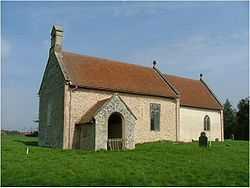Langford, Norfolk
| Langford | |
 Saint Andrew, Langford, Norfolk |
|
 Langford |
|
| Population | 0 (parish, 2001 census) |
|---|---|
| OS grid reference | TL8396 |
| – London | 91.9 miles (147.9 km) |
| Civil parish | Langford CP |
| District | Breckland |
| Shire county | Norfolk |
| Region | East |
| Country | England |
| Sovereign state | United Kingdom |
| Post town | N/A |
| Postcode district | N/A |
| Dialling code | N/A |
| Police | Norfolk |
| Fire | Norfolk |
| Ambulance | East of England |
| EU Parliament | East of England |
Coordinates: 52°32′09″N 0°42′28″E / 52.535709°N 0.707797°E
Langford is a village and former civil parish within the English county of Norfolk. The village is in the Norfolk battle training area of the Ministry of Defence which is an area with a restricted entry. Langford is about nine miles south of the town of Swaffham.
History
Langford has an entry in the Domesday Book of 1085,[1] in which it is recorded as Langaforde. The main landholder is named as Hugh de Montfort and the survey also states that there are two mills, a fishery and two beehives.
Evacuation
During the Second World War, the village was taken over by the British Army when it was incorporated into the Stanford Battle Area. The military ranges were needed to prepare Allied infantry for Operation Overlord, (the Battle of Normandy in 1944). Though some villagers were said to be happy to give up their homes to help the British War effort,[2] the majority were less than enthusiastic with a number of heated village meetings and some refusing to leave the area.[3] This was the subject of a book written by Lucille Reeve, one such person who refused to leave, under the pseudonym A Norfolk Woman called Farming, on a Battle Ground.[4]
However at the close of World War II, the former villagers were never allowed to return to their homes by the War Office. Most of the inhabitants of Langford were not landowners, and rented the houses and farmed the land belonging to the Walsingham estates. Though they had been promised that they could return to their homes after the war, the government later reneged on the promise and bought the land, threatening Walsingham with a compulsory purchase order.[5] As the majority of the inhabitants weren't landowners, they received very little in compensation were put into council housing and many had lost their livelihoods. They continued to fight for many years to return to their homes and farmland but the beginnings of the cold war and the need for dedicated training areas removed all chances of a return.
Since the evacuation, the village and its parish remain within the Ministry of Defence's Thetford infantry training area. Access is not allowed without special permission.
The Parish Church of St Andrew
The parish church is a very simple affair made up of two cells which date from the Norman period.[6] The church once had a medieval tower, but this was lost some time in the 18th century. The bell turret is late Victorian which has been built in a Norman style. The eaves of the church have curious carved faces on the east elevation, a grinning cat to the south, a wild man to the north.
References
- ↑ The Domesday Book, England's Heritage, Then and Now, Editor: Thomas Hinde, Norfolk, p. 186 ISBN 1-85833-440-3
- ↑ Information about the Evacuation
- ↑ Breckland exodus - the forced evacuation of the Norfolk Battle Area 1942:Part 1
- ↑ Lucille Reeve - Eastern Daily Press
- ↑ Breckland exodus - the forced evacuation of the Norfolk Battle Area 1942:Part 2
- ↑ Norfolk 1: Norwich and North-East, by Nikolaus Pevsner and Bill Wilson, Langford entry. ISBN 0-300-09607-0
External links
![]() Media related to Langford, Norfolk at Wikimedia Commons
Media related to Langford, Norfolk at Wikimedia Commons